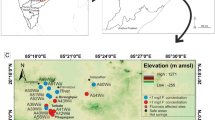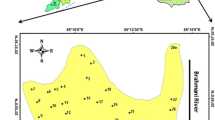Abstract
The most appropriate and widely used source of drinking water for the populations of the upper regions of Ghana is groundwater. In general, groundwater quality is acceptable except for some parts of the Bolgatanga and Bongo Districts, where there are occurrences of elevated levels of natural groundwater fluoride. Concentrations of groundwater fluoride in excess of the World Health Organization (WHO) maximum guideline value (1.5 mg/l) in the Bongo area have been known since 1978. However, the effect of fluoride on people ingesting the water did not receive public and medical attention until October 1993, when health personnel were asked to investigate the cause of stained teeth in school children. The investigation established that 62% of the total population of school children in the Bongo area had dental fluorosis. Against this background, a study was initiated to understand the geochemistry, genesis, and distribution of fluoride in relation to the geology of the area. Groundwater fluoride in the upper regions ranges from 0.11 to 4.60 ppm, with the highest concentrations associated with the fluorine-enriched Bongo coarse-grained hornblende granite and syenite suite. The source of groundwater fluoride within the Bongo granitoids is dissolution of the mineral fluorite and dissolution of and anion exchange with micaceous minerals and their clay products. Applying the WHO recommended guideline values for fluoride in drinking water reveals that 49% of wells in the area deliver water below the optimum level of 0.5 mg/l F–; these populations are thus prone to dental caries. Twenty-eight percent of the wells fall within the optimum interval for good dental health (0.5–1.5 mg/l F–). Twenty-three percent of the wells have concentrations above the recommended maximum guideline limit of 1.5 mg/l F–; this population is susceptible to dental and possibly skeletal fluorosis. Climatic conditions of the area suggest that the individual water consumption is in the order of 3 to 4 l which is higher than the WHO estimate of 2 l/adult/day. In addition, dietary intake for the upper region population is probably higher than WHO baseline values (0.2–0.5 mg/day). This implies that a much higher population is susceptible to developing dental and skeletal fluorosis than originally suspected. Geochemical symbol plot maps help geochemists understand factors controlling the distribution and uptake of fluoride in the upper regions, but they are of minimal value to health officials responsible for planning epidemiological studies and dental health education programs in the region. By casting fluoride data into contoured 'geochemical health-risk maps' using intake interval guidelines more closely aligned to regional climatic and dietary conditions, health officals can better judge the impacts (regional and population based) of fluoride on segments of the population, such as various sex and age groups.
Similar content being viewed by others
Author information
Authors and Affiliations
Additional information
Received: 11 March 1997 · Accepted: 17 June 1997
Rights and permissions
About this article
Cite this article
Apambire, W., Boyle, D. & Michel, F. Geochemistry, genesis, and health implications of fluoriferous groundwaters in the upper regions of Ghana. Environmental Geology 33, 13–24 (1997). https://doi.org/10.1007/s002540050221
Issue Date:
DOI: https://doi.org/10.1007/s002540050221




